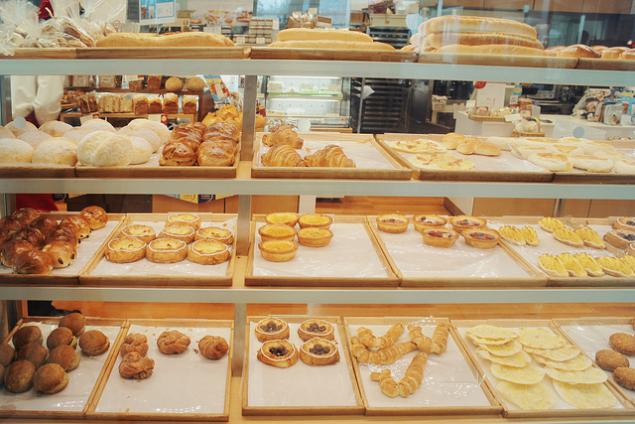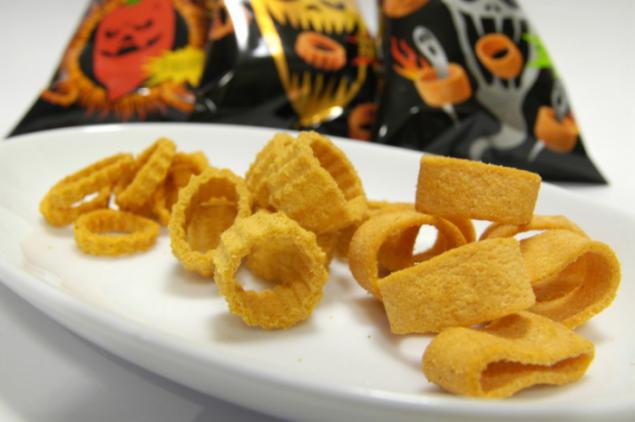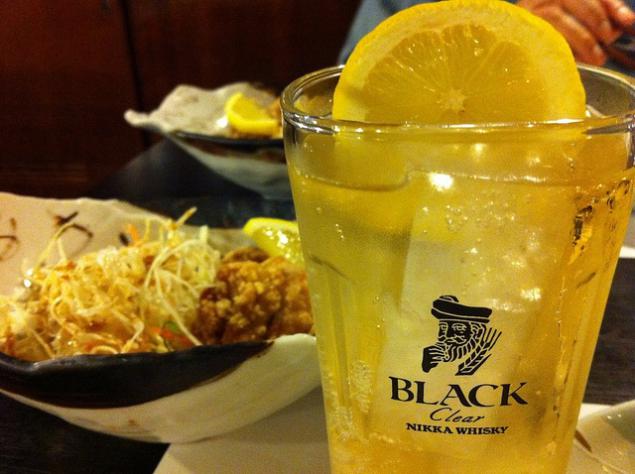877
Japanese delicacies
National dishes and drinks that are worth a try visiting Japan

By the way recently Vasek (Japanese culinary art, means "harmony of food") became an object of cultural heritage.
1. Bread and bakery Japanese
In Japan, like most Asian countries, rice is the staple food. He played a key role in the social and economic history of this country. In addition, until recently, it was used to pay taxes.
After the Meiji Restoration (complex political, military and socio-economic reforms in Japan's 1868-1889), Japanese cuisine is largely subjected to the influence of Western.
Bread has become very popular and now occupies an important place in the food culture of Japan. Just go to any of the many bakeries to see how diverse their range: there will find everything from delicious chocolates and French baguettes, ending rolls with shrimp and sausage in the dough.
The Japanese also invented several new types of baked goods. For example, cocoa-pan (sweet roll, usually filled with azuki bean paste), square-pan (well fried donut stuffed with Japanese curry). Some bakers use rice as a basis for many recipes in an attempt to reduce the popularity of white bread. Bakeries make rice bread in the hope that the consumption of cereal grown in the country will increase.
2. The Japanese ice cream
(Caption: ice cream flavored matches or green tea)
Agree, this is clearly not a product that immediately comes to mind at the mention of Japanese cuisine. However, in this country have been created some unique flavors of ice cream. Among the most popular:
-Match (green tea);
-sakura (cherry blossom);
-batat (sweet potatoes);
-indiysky sesame;
-yudzu (a type of citrus fruit with lemon-tangerine flavor).
There are also more exotic tastes, which in addition to Japan, you will not find anywhere else: basasi (horse sashimi), eel, wasabi (Japanese horseradish).
3. Gekikara ramen and other spicy dishes

It is believed that Japanese food is not included in the number of acute, and some have called it fresh. However, these people probably have never tried to eat at least one bowl of ramen gekikara. This dish of noodles flavored with very hot spices. Those brave souls who still dare to try it, will have to literally sweat. Despite the fact that the Japanese curry sweeter and not as keen on the taste of his Indian counterpart, in some stores you can choose the level of severity of the seasonings to your liking.
4. Raw egg
One of the characteristics of Japanese food is that it is very often used fresh ingredients, which are often served on the table in a crude form. The most famous example - is seafood, including sushi. However, there are other raw foods, occupies a prominent place in Japanese cuisine.
Egg, for example, found in many food recipes: it is usually served with rice or as a sauce for noodles. For a foreigner it is likely to be the greatest difficulty in tasting many Japanese dishes. After all, raw eggs can contain harmful bacteria that cause foodborne illnesses. Therefore, tourists are highly surprised to see raw eggs stored on grocery shelves at room temperature.
However, egg, chicken demolished healthy, with proper treatment is completely safe for consumption. So, if possible, be sure to try each dish with a rather ironic title "Oyakodon" (in Japanese it means "parents and children" because of it, among other things, includes chicken and raw egg). < br />
5. Okonomiyaki and traditional cuisine
Japan - a paradise for gourmands and gourmets from around the world who flock to the land of the rising sun in search of food. This has led to a somewhat distorted perception of Japanese cuisine, so cheap and tasty traditional dishes barely known abroad.
A good example of such a case is okonomiyaki (translated from Japanese means "what you want"). There are many ways to prepare this delicacy. The main ingredients are considered to be vegetables (cabbage, carrots, onions) and meat (squid, pork, shrimp, beef), which cut into cubes and mix with the dough. Prepared dishes teppan like pancakes and seasoned according to your preferences (it can be barbecue sauce, mayonnaise, edible seaweed and dried bonito flakes).
In many institutions, you can cook okonomiyaki: simply order the ingredients and use the grill, built right into the table. This style of "do it yourself" and other popular Japanese dishes, such as the ever-popular takoyaki (octopus balls).
6. Whiskey

You seem strange that in an article about Japanese food, drink mentioned. But whenever it comes to French cuisine, it is practically impossible to forget about French wine. In general, the Japanese love to good whiskey surprising fact, given that the traditional drink in the country is considered sake. However, products distilleries Japan for many years in a row contesting the right adhesive tape for the best drink and often took first place in a blind tasting, as well as international competitions.
Highball cocktail (ginger ale or whiskey and soda served in a tall glass) is popular in the circles of young people, and in business circles. In a recent marketing campaign launched by the Japanese company Suntory, highball emerged as a buzzword to promote a new car hi dishes (fried chicken and highball cocktail).
7. Otsumami
In Japan, the drinks are almost always consumed with food. Therefore, a foreigner by ordering in a restaurant or bar, surprised, when he will bring a completely free plate of potato salad or appetizer of chicken. In fact, there is a whole category of snacks, which is served with drinks. And it is called "otsumami" (from the verb "tsumi", which translates as "pinching" or "stabbing", so you can guess what a delicacy eaten with the fingers).
For this reason otsumami snacks are very popular and are sold in a wide range. Beginners should start with assorted nut or edamame (soybeans), but more exotic appetizers not less tasty. For example, squid jerky or dried anchovies.
Whatever your ideas about traditional Japanese cuisine, Vasek - it is something more than just rice or sushi. Japanese cuisine is huge, amazing and constantly changing. And anyone who wants to try it, be sure to find something.
©

By the way recently Vasek (Japanese culinary art, means "harmony of food") became an object of cultural heritage.
1. Bread and bakery Japanese
In Japan, like most Asian countries, rice is the staple food. He played a key role in the social and economic history of this country. In addition, until recently, it was used to pay taxes.
After the Meiji Restoration (complex political, military and socio-economic reforms in Japan's 1868-1889), Japanese cuisine is largely subjected to the influence of Western.
Bread has become very popular and now occupies an important place in the food culture of Japan. Just go to any of the many bakeries to see how diverse their range: there will find everything from delicious chocolates and French baguettes, ending rolls with shrimp and sausage in the dough.
The Japanese also invented several new types of baked goods. For example, cocoa-pan (sweet roll, usually filled with azuki bean paste), square-pan (well fried donut stuffed with Japanese curry). Some bakers use rice as a basis for many recipes in an attempt to reduce the popularity of white bread. Bakeries make rice bread in the hope that the consumption of cereal grown in the country will increase.
2. The Japanese ice cream
(Caption: ice cream flavored matches or green tea)
Agree, this is clearly not a product that immediately comes to mind at the mention of Japanese cuisine. However, in this country have been created some unique flavors of ice cream. Among the most popular:
-Match (green tea);
-sakura (cherry blossom);
-batat (sweet potatoes);
-indiysky sesame;
-yudzu (a type of citrus fruit with lemon-tangerine flavor).
There are also more exotic tastes, which in addition to Japan, you will not find anywhere else: basasi (horse sashimi), eel, wasabi (Japanese horseradish).
3. Gekikara ramen and other spicy dishes

It is believed that Japanese food is not included in the number of acute, and some have called it fresh. However, these people probably have never tried to eat at least one bowl of ramen gekikara. This dish of noodles flavored with very hot spices. Those brave souls who still dare to try it, will have to literally sweat. Despite the fact that the Japanese curry sweeter and not as keen on the taste of his Indian counterpart, in some stores you can choose the level of severity of the seasonings to your liking.
4. Raw egg
One of the characteristics of Japanese food is that it is very often used fresh ingredients, which are often served on the table in a crude form. The most famous example - is seafood, including sushi. However, there are other raw foods, occupies a prominent place in Japanese cuisine.
Egg, for example, found in many food recipes: it is usually served with rice or as a sauce for noodles. For a foreigner it is likely to be the greatest difficulty in tasting many Japanese dishes. After all, raw eggs can contain harmful bacteria that cause foodborne illnesses. Therefore, tourists are highly surprised to see raw eggs stored on grocery shelves at room temperature.
However, egg, chicken demolished healthy, with proper treatment is completely safe for consumption. So, if possible, be sure to try each dish with a rather ironic title "Oyakodon" (in Japanese it means "parents and children" because of it, among other things, includes chicken and raw egg). < br />
5. Okonomiyaki and traditional cuisine
Japan - a paradise for gourmands and gourmets from around the world who flock to the land of the rising sun in search of food. This has led to a somewhat distorted perception of Japanese cuisine, so cheap and tasty traditional dishes barely known abroad.
A good example of such a case is okonomiyaki (translated from Japanese means "what you want"). There are many ways to prepare this delicacy. The main ingredients are considered to be vegetables (cabbage, carrots, onions) and meat (squid, pork, shrimp, beef), which cut into cubes and mix with the dough. Prepared dishes teppan like pancakes and seasoned according to your preferences (it can be barbecue sauce, mayonnaise, edible seaweed and dried bonito flakes).
In many institutions, you can cook okonomiyaki: simply order the ingredients and use the grill, built right into the table. This style of "do it yourself" and other popular Japanese dishes, such as the ever-popular takoyaki (octopus balls).
6. Whiskey

You seem strange that in an article about Japanese food, drink mentioned. But whenever it comes to French cuisine, it is practically impossible to forget about French wine. In general, the Japanese love to good whiskey surprising fact, given that the traditional drink in the country is considered sake. However, products distilleries Japan for many years in a row contesting the right adhesive tape for the best drink and often took first place in a blind tasting, as well as international competitions.
Highball cocktail (ginger ale or whiskey and soda served in a tall glass) is popular in the circles of young people, and in business circles. In a recent marketing campaign launched by the Japanese company Suntory, highball emerged as a buzzword to promote a new car hi dishes (fried chicken and highball cocktail).
7. Otsumami
In Japan, the drinks are almost always consumed with food. Therefore, a foreigner by ordering in a restaurant or bar, surprised, when he will bring a completely free plate of potato salad or appetizer of chicken. In fact, there is a whole category of snacks, which is served with drinks. And it is called "otsumami" (from the verb "tsumi", which translates as "pinching" or "stabbing", so you can guess what a delicacy eaten with the fingers).
For this reason otsumami snacks are very popular and are sold in a wide range. Beginners should start with assorted nut or edamame (soybeans), but more exotic appetizers not less tasty. For example, squid jerky or dried anchovies.
Whatever your ideas about traditional Japanese cuisine, Vasek - it is something more than just rice or sushi. Japanese cuisine is huge, amazing and constantly changing. And anyone who wants to try it, be sure to find something.
©






















